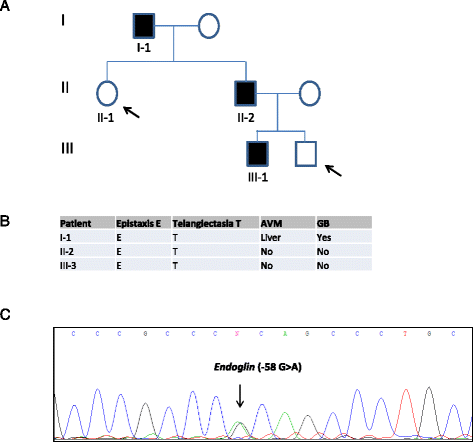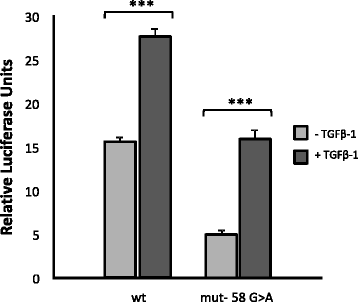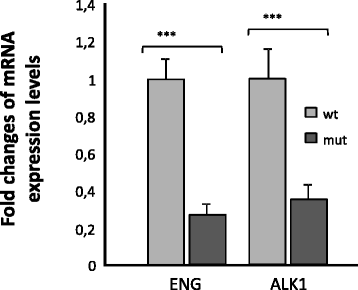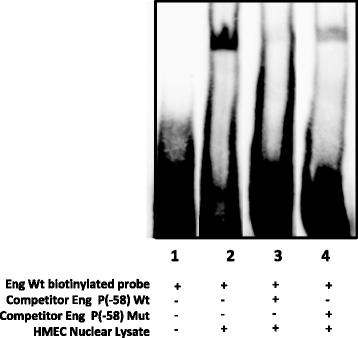Mutation affecting the proximal promoter of Endoglin as the origin of hereditary hemorrhagic telangiectasia type 1
- PMID: 28231770
- PMCID: PMC5324315
- DOI: 10.1186/s12881-017-0380-0
Mutation affecting the proximal promoter of Endoglin as the origin of hereditary hemorrhagic telangiectasia type 1
Abstract
Background: Hereditary hemorrhagic telangiectasia (HHT) is a vascular multi-organ system disorder. Its diagnostic criteria include epistaxis, telangiectases in mucocutaneous sites, arteriovenous malformations (AVMs), and familial inheritance. HHT is transmitted as an autosomal dominant condition, caused in 85% of cases by mutations in either Endoglin (ENG) or Activin receptor-like kinase (ACVRL1/ACVRL1/ALK1) genes. Pathogenic mutations have been described in exons, splice junctions and, in a few cases with ENG mutations, in the proximal promoter, which creates a new ATG start site. However, no mutations affecting transcription regulation have been described to date in HHT, and this type of mutation is rarely identified in the literature on rare diseases.
Methods: Sequencing data from a family with HHT lead to single nucleotide change, c.-58G > A. The functionality and pathogenicity of this change was analyzed by in vitro mutagenesis, quantitative PCR and Gel shift assay. Student t test was used for statistical significance.
Results: A single nucleotide change, c.-58G > A, in the proximal ENG promoter co-segregated with HHT clinical features in an HHT family. This mutation was present in the proband and in 2 other symptomatic members, whereas 2 asymptomatic relatives did not harbor the mutation. Analysis of RNA from activated monocytes from the probands and the healthy brother revealed reduced ENG mRNA expression in the HHT patient (p = 0.005). Site-directed mutagenesis of the ENG promoter resulted in a three-fold decrease in luciferase activity of the mutant c.-58A allele compared to wild type (p = 0.005). Finally, gel shift assay identified a DNA-protein specific complex.
Conclusions: The novel ENG c.-58G > A substitution in the ENG promoter co-segregates with HHT symptoms in a family and appears to affect the transcriptional regulation of the gene, resulting in reduced ENG expression. ENG c.-58G > A may therefore be a pathogenic HHT mutation leading to haploinsufficiency of Endoglin and HHT symptoms. To the best of our knowledge, this is the first report of a pathogenic mutation in HHT involving the binding site for a transcription factor in the promoter of ENG.
Keywords: Endoglin promoter; Hereditary hemorrhagic telangiectasia (HHT); Rare disease; Transcription regulation.
Figures





Similar articles
-
Clinical and genetic analyses of three Korean families with hereditary hemorrhagic telangiectasia.BMC Med Genet. 2011 Oct 3;12:130. doi: 10.1186/1471-2350-12-130. BMC Med Genet. 2011. PMID: 21967607 Free PMC article.
-
Mutation analysis of "Endoglin" and "Activin receptor-like kinase" genes in German patients with hereditary hemorrhagic telangiectasia and the value of rapid genotyping using an allele-specific PCR-technique.BMC Med Genet. 2009 Jun 9;10:53. doi: 10.1186/1471-2350-10-53. BMC Med Genet. 2009. PMID: 19508727 Free PMC article.
-
The ACVRL1 c.314-35A>G polymorphism is associated with organ vascular malformations in hereditary hemorrhagic telangiectasia patients with ENG mutations, but not in patients with ACVRL1 mutations.Am J Med Genet A. 2015 Jun;167(6):1262-7. doi: 10.1002/ajmg.a.36936. Epub 2015 Apr 2. Am J Med Genet A. 2015. PMID: 25847705 Free PMC article.
-
Endoglin and alk1 as therapeutic targets for hereditary hemorrhagic telangiectasia.Expert Opin Ther Targets. 2017 Oct;21(10):933-947. doi: 10.1080/14728222.2017.1365839. Epub 2017 Aug 20. Expert Opin Ther Targets. 2017. PMID: 28796572 Review.
-
Hereditary hemorrhagic telangiectasia: an update on clinical manifestations and diagnostic measures.Wien Klin Wochenschr. 2006 Mar;118(3-4):72-80. doi: 10.1007/s00508-006-0561-x. Wien Klin Wochenschr. 2006. PMID: 16703249 Review.
Cited by
-
Non-Coding RNAs and Hereditary Hemorrhagic Telangiectasia.J Clin Med. 2020 Oct 17;9(10):3333. doi: 10.3390/jcm9103333. J Clin Med. 2020. PMID: 33080889 Free PMC article. Review.
-
A novel frameshift mutation of the endoglin(ENG) gene causes hereditary hemorrhagic telangiectasia in a Chinese family.Eur Arch Otorhinolaryngol. 2024 Jan;281(1):237-243. doi: 10.1007/s00405-023-08186-4. Epub 2023 Aug 21. Eur Arch Otorhinolaryngol. 2024. PMID: 37603052
-
Endothelial cilia dysfunction in pathogenesis of hereditary hemorrhagic telangiectasia.Front Cell Dev Biol. 2022 Nov 10;10:1037453. doi: 10.3389/fcell.2022.1037453. eCollection 2022. Front Cell Dev Biol. 2022. PMID: 36438574 Free PMC article.
-
Characterization of a family mutation in the 5' untranslated region of the endoglin gene causative of hereditary hemorrhagic telangiectasia.J Hum Genet. 2019 Apr;64(4):333-339. doi: 10.1038/s10038-019-0564-x. Epub 2019 Feb 6. J Hum Genet. 2019. PMID: 30728427 Free PMC article.
-
Transforming Growth Factor-β: An Agent of Change in the Tumor Microenvironment.Front Cell Dev Biol. 2021 Oct 12;9:764727. doi: 10.3389/fcell.2021.764727. eCollection 2021. Front Cell Dev Biol. 2021. PMID: 34712672 Free PMC article. Review.
References
-
- Shovlin CL, Guttmacher AE, Buscarini E, Faughnan ME, Hyland RH, Westermann CJ, Kjeldsen AD, Plauchu H. Diagnostic criteria for hereditary hemorrhagic telangiectasia (Rendu-Osler-Weber syndrome) Am J Med Genet. 2000;91:66–67. doi: 10.1002/(SICI)1096-8628(20000306)91:1<66::AID-AJMG12>3.0.CO;2-P. - DOI - PubMed
-
- McAllister KA, Grogg KM, Johnson DW, Gallione CJ, Baldwin MA, Jackson CE, Helmbold EA, Markel DS, McKinnon WC, Murrell J, et al. Endoglin, a TGF-beta binding protein of endothelial cells, is the gene for hereditary haemorrhagic telangiectasia type 1. Nat Genet. 1994;8:345–351. doi: 10.1038/ng1294-345. - DOI - PubMed
MeSH terms
Substances
LinkOut - more resources
Full Text Sources
Other Literature Sources

